Five trends driving modern office fit out in London
Office fit out has changed massively in just 3 years. We all know that. Employers and designers have scrambled to reorientate the office to meet the new hybrid working landscape. There’s a fairly good understanding of the workplace – less desk numbers, fewer staff working 5 days in the office, more collaboration space and more personalized space. The Users has more control on where to work, both within the office and externally.
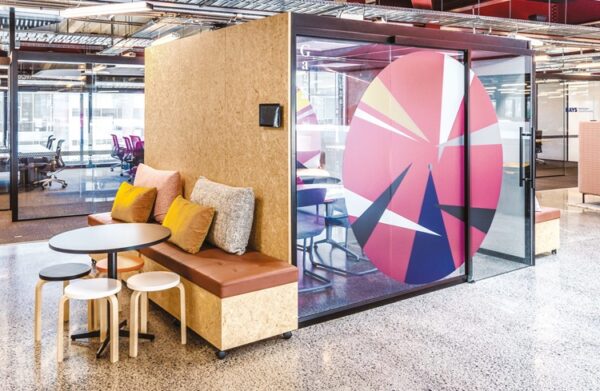
Is there now a glimmer of change ahead? Workers are commenting that the more they work from home, separated from colleagues, the more being in proximity matters to them. Both to their work and their involvement in organisational culture. FOMO. Call it what you want. Teams calls just can’t bring us together the way we want. It turns out that co-workers need to work together, in person. Perhaps this is an inevitable realisation at the end of a covid hiatus. Meeting face-to-face is just more effective and less draining. Brainstorming problems and tasks, learning from the experience of others in the moment, socializing at work, or just connecting with each other’s lives again. This is the substance of business culture. There is always a need to improve work relationships, mentor staff for the micro and macro elements, monitor the missteps and build towards shared purpose. Its not yet a trend… but a light at the end of the tunnel.
RTO, return to office, is making some headway. A little. We’re noticing that London streets and commuter trains are getting busier. Now staff are saying one of the reasons to come back into the office more is to focus on work within the organisation, not parallel to it. Sure we’ve seen that meeting spaces for colleagues, or with clients, is a key element of any office fit out. And access to dedicated personal spaces, be they focus driven or collaboration driven, are popular when done right. Socializing and professional development are still important, they just went away for a time whilst we stayed safe. Perhaps now…working in the office might be coming back.
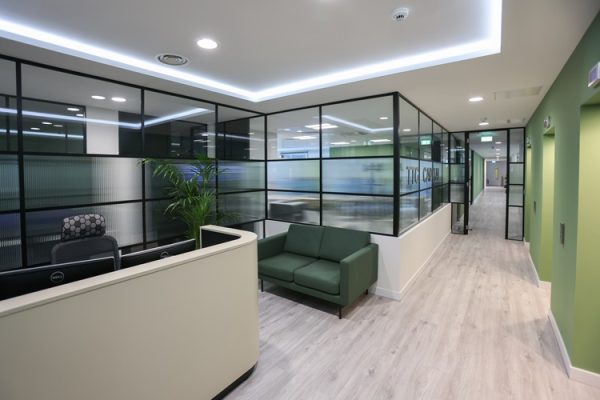
A positive is that the winning features of the office are already in place. Office fit out, and may I say office fit out companies, have just got better over time. But there is still a disconnect between current office interiors and what staff are seeking. Office workers say they want to increase their presence in the office to get back to previous levels of productivity. They just need a catalyst to be there more. A lot of change in office fit-outs was already underway in the last 5 years; more crossover between hotel, resi and commercial interiors being the top line. However underneath this trend new needs, new priorities and expectations are emerging as we gather pace on RTO.
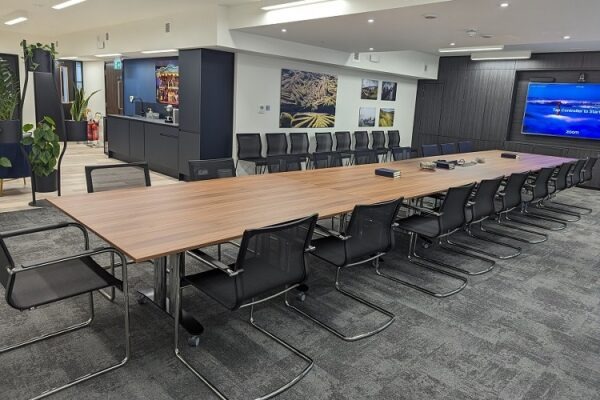
Some workplace trends that are driving priorities for the new office fit out in London:
- We still want to be mobile. Work from anywhere and be more autonomous.
Productivity is back in focus. Higher job satisfaction is often about better work-life balance but its become clear we still need to pay the bills. Mobility and autonomy are nice and staff don’t want to lose them. Office fit-outs still need to cater to keyboard warriors when they come in.
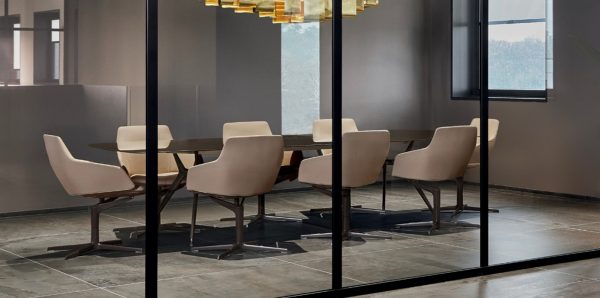
Commitment and engagement, always hard to measure, are intangibles that are still linked with flexible working.
Attracting the next generation of talented people has never gone away. Companies should retain a forward-looking mobility policy as it’s a sign of trust. Hybrid working (mixing office days with working from home) seems as popular as ever…just not so balanced towards WFH. Any office interior needs the flexibility to get more people back at desks, pods, meeting rooms and breakout areas. The sag in office attendance will lessen over time.
As staff use the office more steadily attendance has settled around 50% of their typical work week working in offices, 20% at home and the remainder is spent at other business sites, café working, perhaps co-working spaces, and working whilst travelling.
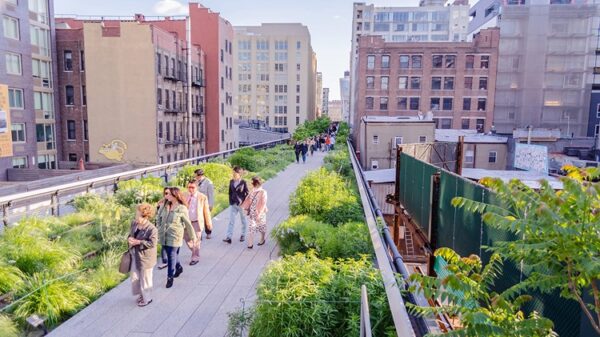
- User Chooser: Not just the desk or WFH
As far back as 2013 surveys identified employers who provide a range of choices for where to work, and even when to work, were rated more highly and had higher-performing staff. More recently research suggested workers at companies rated ‘innovative’ spend more time collaborating, in different settings rather than at desks, and spend only around 70% of their working week actually in the office. The desire for flexible working doesn’t mean a one-size fits-all strategy. When considering the spatial and adjacency aspects of office interiors many workers need to be within teams or groups whilst at work. Historic departmental zones do still apply, but also they do need readily available resources at their offices such as focus spaces, collaborative areas and event spaces. Interestingly we’re becoming more versatile and agile post pandemic, learning to work in different ways, To make the best of this we need a wide range of solutions inside the office to support all styles of work.
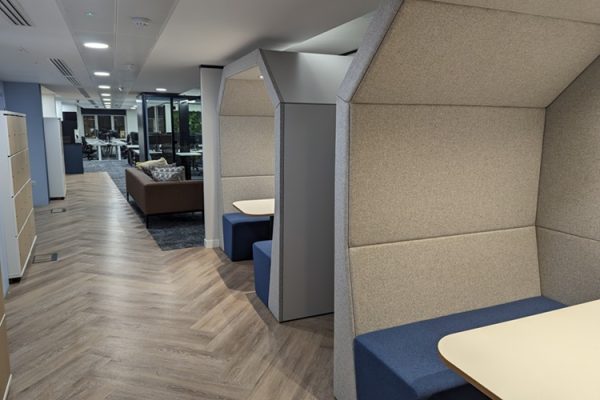
Neighbourhoods play a useful role in ad-hoc places to work, including coffee shops and coworking drop-in desk space. A recent trend is seeing companies with highly rated workspace policies more likely to be located in vibrant surroundings where overspill space is very much on hand and well used. As an extension of the office the mix of ad-hoc space can be a powerful combination, compared to a business district such as Canary Wharf.
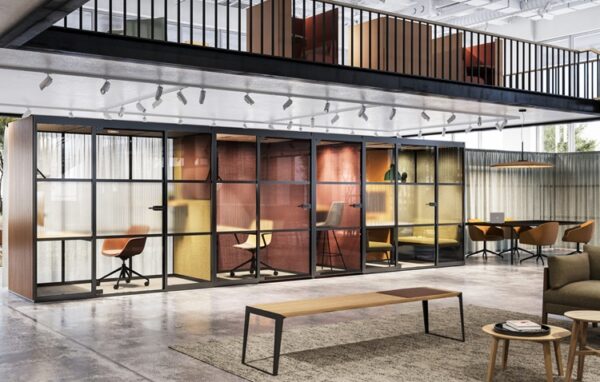
- Easy Access Privacy.
Open-plan office fit-out morphed into broken-plan as the wide open spaces gave way to offices with more segmentation. Now we’re seeing this trend move forward into floors with phone booths, small pods as well as more cellular meeting rooms.
The pod and booth explosion actually started in the early 2000s, but has really gone mainstream in the last 4 years, boosted again as we return to the office. Pods have become more cost-effective as choice becomes widespread. They’re easier to move than the early versions. And the range of sizes, acoustic levels, and design improvements means everyone possible wish can be accommodated.
The rise of unassigned desking, and reduction in overall desk numbers in the office, underpin a need for more ‘3rd’ spaces either for small collaborative areas, one-to-one or solo. Defined furnishing solutions for focusing, or personal use, that aren’t occupied for long time periods, give staff the feeling of control and privacy on demand.
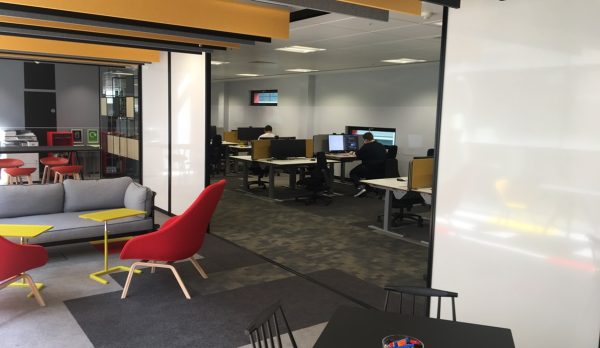
Time in the office spent in the most appropriate setting, either secluded, with co-workers, or in Teams spaces, certainly lends more control over workplace for staff, which is possibly one of the preferred aspects of WFH.
When evaluating the whole of the office environment take into account the balance of workstations, rooms, dedicated enclosed pods, team meeting rooms, and focus spaces. Noise, privacy, and focus remain key factors for the office build-out. Setting a good balance between open/private and individual/group spaces has always been important but now that total desk numbers aren’t pre-eminent its easier to strike a more varied approach.
Working solo is something we all do yet this is one of the lowest valued modes in the office. Area such as quiet or tech-free zones, possibly libraries, don’t seem to be as popular as you’d imagine. We need some background hubbub, which is one reason WFH may be reducing somewhat. On the flip side spaces to recharge or even to pause for thought, including mediation spaces and outdoor seating, do answer the requests for privacy.
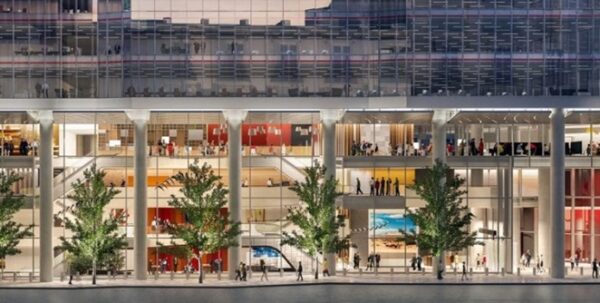
- Destination office.
Make the office a destination. Put health and wellness, activities and discovery, participation and FOMO, into your office fit-out thinking. Outdoor spaces, health conscious refreshment, and activity encouragement, all make the office a place to be. If WFH means ‘better’ than the office and more comfortable as well, why commute. Offices must now work harder than ever to establish how their amenities will draw in employees.
If your staff are more likely to say working in the office positively impacts personal health and well-being then it’s a great way to shift the hybrid balance more towards the office. And if working in the office helps with connection to colleagues, task, and company then great…win-win.
Onto that, add pop-ups and social reasons to RTO, and its going to be harder to work from home, easier for the hybrid week to have more time in the office diarized.
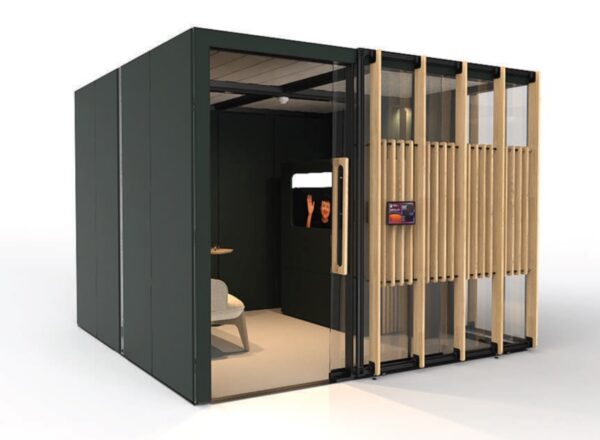
Psychology 1.01 says it takes 28 days to form a habit, 14 days to break one. Lockdown was 90 days. Forming the reasons to work in the office more takes lots of effort to put in the foundations. Making it a habit takes 28 days of carrot.
There is growing evidence on the flight to quality. Demand for the best office space, not just new or newly upgraded, but high quality with added-value is a trend. Organisations are right-sizing and in the process are looking for commercial space with more. Better office fit-outs, amenities on site, social events…added distinctiveness to make the journey into work more compelling. Allied to this is a renewed focus on location. City of London and West End are back as the number 1s. Moving to peripheral areas, be it Docklands, Paddington or Borough, is effective only if the building can compete on every level.
- Hybrid doesn’t have to be TWAT.
Encourage hybrid but alter the Tuesday, Weds and Thursday predominance. As a new norm its anchoring our diaries. The cloud and Teams have meant physical participation isn’t dictated. But as we know too well, on-screen meetings can be draining, less productive and easy to hide in plain sight.
However hybrid isn’t going to go away. Although more than half of meetings are still hybrid, with both in-person and virtual participants, it’s a long way from everyone in the room. You can even take your speed awareness course from home. The downside is that working virtually with others has declined in rating and is now at its lowest effectiveness level. Better technology, better understanding of how to lead online meetings and collaboration, and the ways in which fit out design for hybrid work can help, all combine to get the best out of hybrid.
Whilst office environments have been updated extensively in the last three years perhaps it’s time to rethink the office fit out for staff in-person, and for those who are virtual, now that we can be more confident hybrid is here to stay.
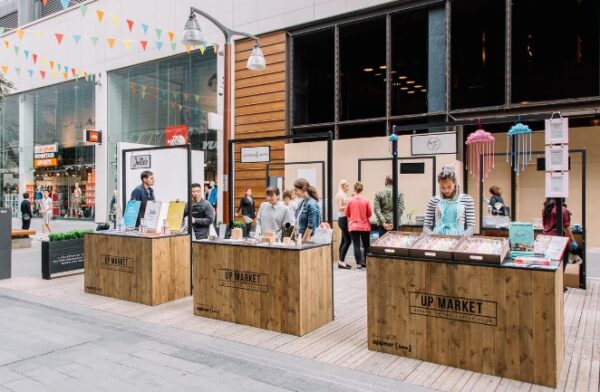
Future workplace
We all value the collective effort; the experience of being together, the social stuff that people do around the office. And getting work done will always pay the bills. The office matters but maybe we’ve forgotten why. As a place to come together for both individual and team working. Having said that staff don’t want to let go of flexibility, control, and privacy. Working with others virtually does work… just not as well as being together.
There’s a social trend in lock-step. Labelled the ‘hermit consumer’ we’re shopping from home more than ever. Added together with WFH and its a trend away from venturing out. Is this a good thing?
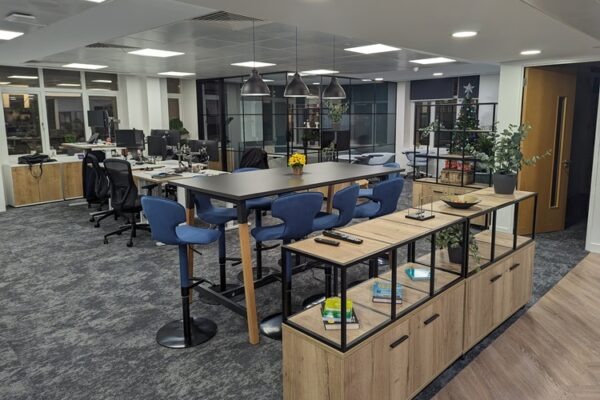
Office Fit Out Costs – a possible scenario.
We’re often asked about the trend in office fit out costs. Are prices subsiding after 18 months of rises? Whilst price pressure has definitely abated its not clear if there will be room for deflationary moves. Although new office Leases are not as strong there could be a significant move from Landlords to either upgrade their space to compete with outstanding new developments, or to repurpose tired commercial buildings. If these produce growth in demand for trades and materials there will be enough wind in the sails to hold costs steady. Another aspect to supply and demand is the ‘lumpy’ nature of the market. its stop-start and has been for 12 months. Political or geopolitical events, mini bank / lending glitches, have all combined to make office fit-out demand sporadic. Worse than sporadic…feast and famine. Too much is not a good thing as it stretches capabilities to breaking point. Not enough demand means labour drifts off to other industries or other markets within construction. On a positive note steady materials costs mean costed bids are more robust and less likely to fall foul of cost surges.
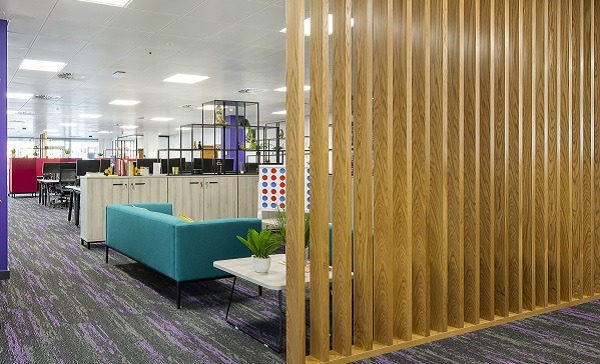
If you have a great office employees will put it as their preferred place to work. Good to great office fit-out is a must-have, but can’t do the heavy lifting alone. The 3 years of post-pandemic investment in office build-out upgrades have shown that on its own this falls short. A plan for a great office needs to bring lifestyle factors as well. The chief fun officer now has a new role…chief destination officer. Make the office a destination, use the 28 day rule as a yardstick, and maybe you’re on-route to the next era of office and workplace utilisation.
To find out more about the office fit-out services from Fusion Office design click here.